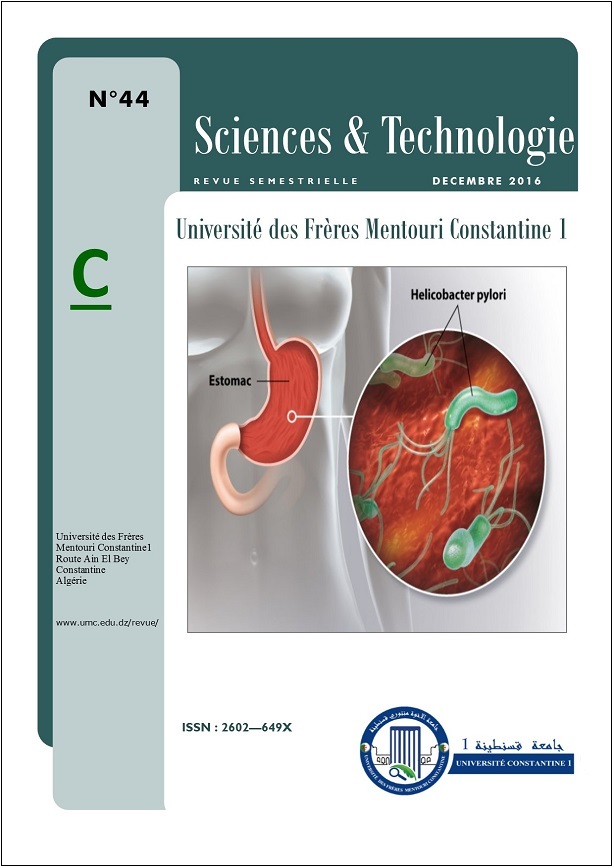GENETIC AND HEMATOLOGICAL PROFILES OF Β-THALASSEMIAS IN EASTERN ALGERIA
Mots-clés :
β-thalassemia, anemia, polymorphism, MTHFR, CYP1A1, RFLP-PCRRésumé
The present work is a retrospective cross-sectional study of cases of β-thalassemia in the Pediatric Department of the Constantine Regional Military Hospital (HMRUC) over a period of 3 months. Our objective is to study through these patients, on the one hand, the epidemiological and para-clinical aspects of β-thalassemia, and on the other hand, a genetic study by searching by RFLP-PCR for possible associations between T3801C polymorphisms of the gene CYP1A1 and C677T of the MTHFR gene and β-thalassemia. We collected during this period 36 cases of β-thalassemias aged between 3 months and 10 years with an average of 1.9 years and a sex ratio (M/F) of 2.25. The parents are consanguineous in 55,56% of the cases. The blood count was marked by pseudo-polycythemia and hypochromic microcytic anemia in thalassemic trait carriers and a decrease in red blood cell count and severe microcytic anemia in patients with severe forms. Hemoglobin electrophoresis revealed heterozygous β-thalassemia in 11 cases (30.55%) and homozygous β-thalassemia in 25 cases (69.44%). Statistical analysis of the preliminary results of molecular genotyping, represented by Odds ratio and the p-value, indicates the absence of association between the polymorphisms, C677T of MTHFR and T3801C of CYP1A1 and β-thalassemia. However, the size of the sample does not make it possible to invalidate or to confirm with certainty the presence or absence of this association.
Références
AL-SWEEDAN SA, JARADAT S, IRAQI M, BESHTAWI M. 2009. The prevalence of factor V Leiden (G1691A), pro thrombin G20210A and methylentetrahydrofolate reductase C677T mutations in Jordanian patients with beta-thalassemia major. Blood Coagulation and Fibrinolysis. 20 (8): 675-678.
BEDIR L, MILOUDI R. 2006. Prévalence de thalassémie dans la wilaya d’El-Oued. Mémoire de fin d’études supérieures en Biochimie. Université Kasdi-Merbah. pp44-45.
BELHADI K. 2011. Etude des hémoglobinopathies dans la population de la région de Batna. Mémoire de Magister en Biologie cellulaire et physiologie animale. Université El-Hadj-Lakhdar. pp 29-57.
BONELLO-PALOT N, CERINO P, JOLY P, BADENS C. 2016. Les thalassémies en 2016. Revue Francophone Des Laboratoires. 481: 67-75.
COUQUE N, DE MONTALEMBERT M. 2013. Diagnostic d’une hémoglobinopathie. Feuillets de Biologie. 311: 5-18.
COUQUE N, TRAWINSKI E, ELION J. 2016. Génétique des maladies de l’hémoglobine. Revue Francophones Des Laboratoires. 481 : 49-60.
DESROSIERS P. 2003. La thalassémie mineure. Le Médecin du Québec. 10 (38): 59.
JOLY P, PONDARRE C, BADNES C. 2014. Les beta-thalassémies: aspects moléculaires, épidémiologiques, diagnostiques et cliniques. Annales de Biologie Clinique.72 (6) : 641-664.
DJEMAA I. 2013. Mise au point de la DGGE en vue du diagnostic des bêta thalassémies et drépanocytose. Mémoire de Magister en génétique moléculaire des populations humaines. Université de Tlemcen. pp11-20.
DJENOUNI A, GRIFI F, BAHLOULI M. Prise en charge des thalassémies majeures au CHU Annaba allant de 1995 à 2002.
DOGARU M, TALMACI R, CORIU D, BADELITA S. 2011. Sensitivity, specificity and efficiency of different discriminative indexes in differentiation of thalassemia trait from iron deficiency anemia. Biointerface Research in Applied Chemistry. 1 (1): 2-8.
GALANELLO R, ORIGA R. 2010. Beta-thalassemia. Orphanet Journal Of Rare Diseases. 5:1-15.
HADDAD N, BRADAI M. 2016. Epidémiologie de la béta thalassémie hétérozygote, dans le CHU de Blida: Implications, pour le dépistage de la population. Santé-Mag. 53: 10-13.
IOLASCON A, GIORDANO P, STORELLI AS, LI HH, COPPOLA B, PIGA A, FANTOLAE, FORNI G, CIANCIULLI P, PERROTTA S, MAGNANO C, MAGGIO A,MANGIAGLI A, DEVOTOB M. 2001. Thrombophilia in thalassemia major patients: analysis of genetic predisposing factors. Haematologica. 86 (10): 1112-1113.
LAHLOU S. 2016. Profil épidémio-clinique, biologique, thérapeutique et évolutif de la thalassémie chez l’enfant. Thèse de doctorat en médecine. Université de Sidi Mohammed Ben Abdellah. pp 80-82.
LOUTFI A, JACHE S, EL HIOUI M, KHATTAB M, AHAMI OT. 2015. Profil hématologique et nutritionnel chez les malades béta thalassémies majeur (BTM) au service d’hématologie et d’oncologie pédiatrique SHOP Hôpital d’enfant de Rabat, Maroc. International Journal of Innovation and Scientific Research. 2 (23) : 268-273.
MARIO N, SALA N. 2016. Diagnostic biologique des hémoglobinopathies. Revue Francophone des Laboratoires. 481 : 35-47.
MUSTAFA NY, MAROUF R, AL-HUMOOD S, AL-FADHLI SM, MOJIMINIVI O. 2010. Hypercoagulable state and methylenehydrofolate reductase (MTHFR) C677T mutation in patients with beta-thalassemia major in Kuwait. Acta Haematologica. 123: 37-42.
PICAUT C. 2006. Contribution a l’étude statistique de la formule leucocytaire manuelle chez le chien : effet frottis et effet observateur. Thèse de doctorat de vétérinaire. Ecole Nationale Vétérinaire de TOULOUSE. pp19-21.
RAHIMI Z, GHADERI M, NAGEL RL, MUNIZ A. 2008. Prevalence of thrombotic risk factors among beta-thalassemia patients from Western Iran. Journal of Thrombosis and Thrombolysis. 26 (3): 229-233.
ROMDHANE H, AMRA H, ABDELKEFI S, SOUYEH N, CHAKROUN T, JARREY I,BOUSLA MA, BELHEDI S, HUOUISSA B, BOUGHAMMOURA L, JEMNIYACOUB S. 2014. Profil clinic-biologique et immuno hématologique des patients atteints de beta thalassémies en Tunisie: à propos de 26 cas. Transfusion clinique et pathologique.6 (21) : 309-313.
SALL A, TOURE AO, SENE A, DIATTA A, CISSE F, SECK M, FAYE B, DIOP S. 2014. Approche diagnostique par le phénotype de la beta-thalassémie hétérozygote à Dakar. CAMES SANTE. 1(2) : 41-44.
ZALLOUA PA, SHBAKLO H, MOURAD YA, KOUSSA S, TAHER A. 2003. Incidence of thromboembolic events in Lebanese thalassemia intermedia patients. Thrombosis and Haemostasis. 89: 767-768.

